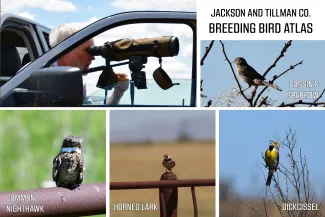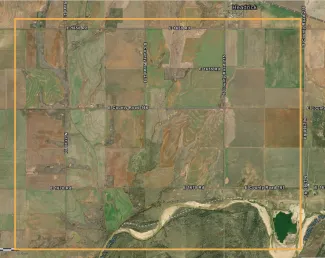For most fish and wildlife surveys, a general goal is to count as many species or individuals as possible. But for Breeding Bird Atlas surveys, the goal is a little more targeted: to document the highest level of breeding evidence for as many species as possible. Biologists surveying the 3-mile-by-3-mile block located in Jackson and Tillman counties this spring and summer weren't just recording birds detected within the block. They were also recording any observations of potential breeding behaviors, including males singing, adults carrying food or nesting materials, performing territorial or courtship displays, or sitting on nests.
“In three separate visits to the survey block, we were able to document behavior suggesting possible or probable breeding for 27 species and confirmed breeding behavior in another 19 species,” said Cheyenne Gonzales, a wildlife biologist with the Wildlife Department. “We watched Cassin’s sparrows as they performed their display flights in early May; saw scissor-tailed flycatchers sitting on nests in late May; and spotted young dickcissels, Bullock’s orioles, and horned larks in late June.”

The block is one of 583 scheduled to be surveyed from 2020 – 2024 as part of the second Oklahoma Breeding Bird Atlas, coordinated by the Sutton Avian Research Center. About 120 blocks have been surveyed each year of the five-year project window. During the year a block is surveyed, volunteers spend at least 10 hours observing birds within their assigned blocks between Feb. 15 and Aug. 15.

Biologists surveyed a 3-mile-by-3-mile block along the North Fork of the Red River in Jackson and Tillman counties. Habitat within the block consisted largely of agricultural land, mesquite scrubland, grazed sandhills, and a four-block section within the town of Headrick.
To capture the widest swath of breeding birds, at least one visit is scheduled for each block between mid-February and mid-May of the year it is surveyed and at least one visit is scheduled between mid-May and mid-August. During the survey, observers carefully watch for breeding behaviors and assign each bird detected to one of 20 codes ranging from “observed” to “nest with young seen or heard.” When the individual surveys are compiled, biologists can then compare the breeding birds documented during the second atlas to the those recorded in the first, conducted from 1997 – 2001, to identify any changes in bird distribution and status across the state.
During the first atlas effort, fewer than 30 species were listed as possible, probable, or confirmed breeders in the block revisited by the Wildlife Department in 2024. For this second effort within the atlas block, breeding behavior was documented for 46 species. An additional 11 species were observed without any marked breeding behaviors, for a total of 57 bird species documented in 2024. While driving in the survey block, biologists also documented a black-tailed jackrabbit, two plains box turtles, and at least three Texas horned lizards.
2024 Breeding Bird Atlas Block Results
Confirmed Breeding Birds | |
|---|---|
| American Kestrel | Killdeer |
| Mourning Dove | Western Kingbird |
| Scissor-tailed Flycatcher | Horned Lark |
| Cliff Swallow | Barn Swallow |
| Northern Mockingbird | European Starling* |
| Dickcissel | Cassin’s Sparrow |
| Grasshopper Sparrow | Lark Sparrow |
| Eastern Meadowlark | Red-winged Blackbird |
| Common Grackle | Bullock’s Oriole |
| House Sparrow* | |
Probable Breeding Birds | |
|---|---|
| Red-tailed Hawk | Northern Bobwhite |
| Black-necked Stilt | White-winged Dove |
| Eurasian Collared-Dove* | Common Nighthawk |
| Ladder-backed Woodpecker | Ash-throated Flycatcher |
| Northern Cardinal | Blue Grosbeak |
| Brown-headed Cowbird | House Finch |
Possible Breeding Birds | |
|---|---|
| Green Heron | Mississippi Kite |
| Swainson’s Hawk | Yellow-billed Cuckoo |
| Greater Roadrunner | Red-headed Woodpecker |
| Bell’s Vireo | Bewick’s Wren |
| Blue-gray Gnatcatcher | Eastern Bluebird |
| American Robin | Painted Bunting |
| Field Sparrow | Western Meadowlark |
| Great-tailed Grackle | |
Observed Species | |
|---|---|
| Great Blue Heron | Cattle Egret |
| White-faced Ibis | Turkey Vulture |
| Greater Yellowlegs | Lesser Yellowlegs |
| Upland Sandpiper | Least Tern |
| Eastern Kingbird | Lark Bunting |
| Bobolink | |
* Denotes non-native species that were detected within the Breeding Bird Atlas block.
The second Oklahoma Breeding Bird Atlas is supported by State Wildlife Grant F21AF03463. Surveys of the Jackson and Tillman counties Breeding Bird Atlas block conducted in 2024 were funded by State Wildlife Grant F22AF02644.